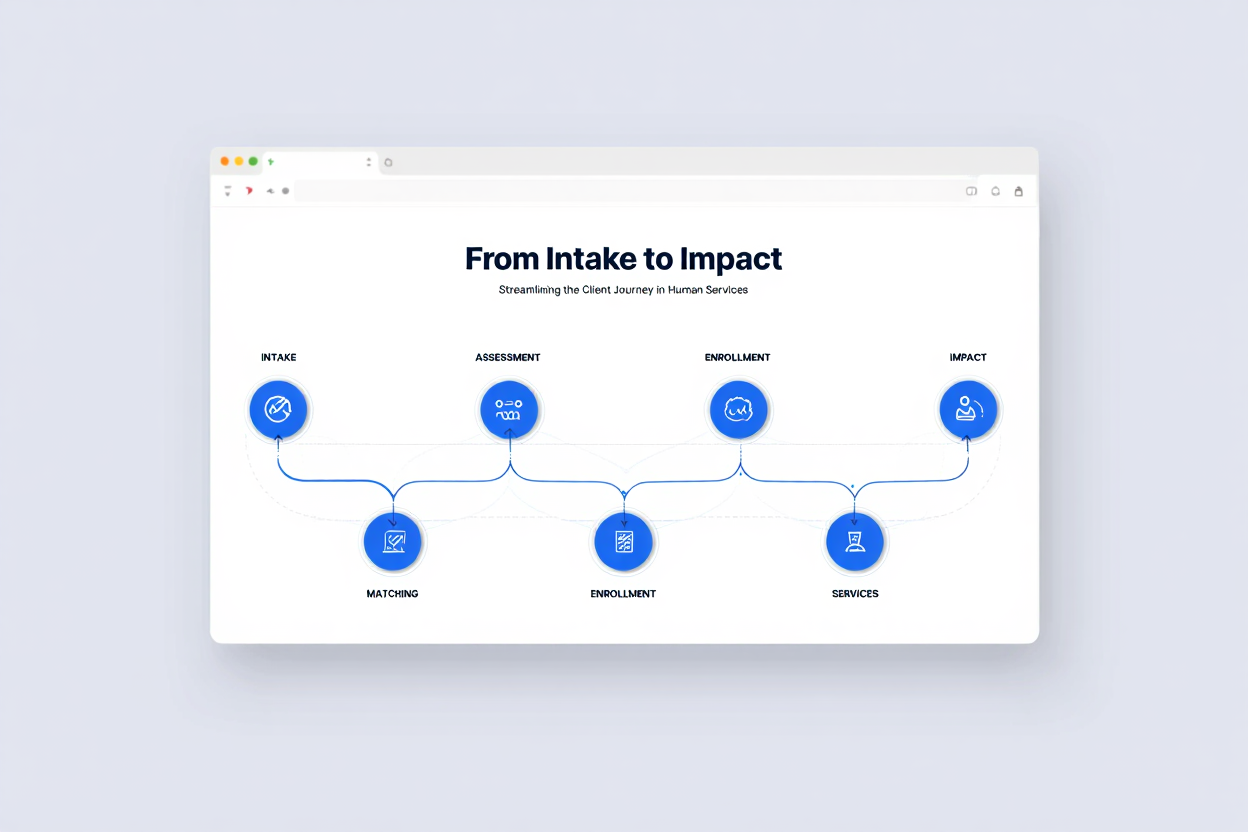Why the Client Journey Shapes Outcomes
In human services, a client’s experience with your nonprofit begins long before you deliver your first service. It starts with how easy it is to connect, share information, and feel understood.
The path from initial intake to measurable impact is called the client journey. Optimizing this journey matters because it determines:
- How quickly people get help
- How efficiently your staff can respond
- How well you track and measure outcomes for funders
This article breaks down each stage of the client journey in human services, common roadblocks, and how technology can remove them — so you deliver more value with the same or fewer resources.

1. Understanding the Client Journey in Human Services
A client journey is the full lifecycle of a person engaging with your organization, from first contact to long-term follow-up. In human services, it typically has five stages:
- Awareness: The client hears about your services.
- Intake: They provide information so you can assess needs.
- Service Delivery: You deliver programs, resources, or referrals.
- Follow-Up: You check progress and offer continued support.
- Closure/Outcomes: Services conclude and outcomes are documented.
Each stage has opportunities for efficiency gains — and risks for delays, errors, or missed opportunities.
2. Common Bottlenecks in the Client Journey
Even well-run nonprofits face friction points that slow service delivery:
- Paper-based intake that delays service start times
- Duplicate data entry across multiple systems
- Poor communication between caseworkers, leading to gaps in service
- Inconsistent follow-up because reminders are manual
- Lack of data visibility for funder reporting
These issues don’t just impact clients — they drain staff time and can affect funding renewals.
3. Stage 1 – Intake: Making First Contact Seamless
The intake process sets the tone for the entire relationship. Long forms, unclear instructions, or repeated questions can frustrate clients before they even receive help.
Best Practices for Efficient Intake
- Offer multiple intake channels: online forms, phone, in-person.
- Use smart forms: pre-fill known data and hide irrelevant questions.
- Automate data capture: send information directly into your case management system.
- Instant confirmations: let clients know their request was received.
4. Stage 2 – Service Delivery: Reducing Delays
Once intake is complete, clients should move into service delivery quickly. The biggest cause of delays? Manual coordination.
How to Speed Up Service Delivery
- Centralized records: all case notes, documents, and communications in one place.
- Role-based task assignments: automatically assign follow-up tasks to the right staff.
- Real-time status tracking: see where each client is in the process at a glance.
This not only speeds up delivery but ensures no step is missed.
5. Stage 3 – Follow-Up: Keeping Clients Engaged
Follow-up is critical for measuring impact and maintaining engagement. Missed follow-ups can lead to unmet needs and weaker program results.
Ways to Automate Follow-Up
- Automated reminders: schedule calls, texts, or emails directly from your CRM.
- Pre-set check-in templates: use standardized forms to track progress consistently.
- Progress dashboards: visualize client outcomes for quick reference.
By removing manual reminders, staff can focus on quality interactions instead of chasing paperwork.
6. Stage 4 – Closure and Outcomes: Proving Your Impact
The last stage isn’t just about ending services — it’s about capturing proof of your success.
Best Practices for Outcome Tracking
- Standardized outcome measures: define what success looks like for each program.
- Automatic data aggregation: pull service history and follow-up notes into a single report.
- Funder-ready exports: create shareable reports in minutes, not days.
Outcome tracking isn’t just a compliance step. It’s a marketing asset — you can share impact data with funders, donors, and the public to build trust and secure future funding.
7. Technology as the Backbone of a Streamlined Client Journey
Many nonprofits still rely on paper, spreadsheets, or outdated CRMs. Modern case management platforms like ShareVision can:
- Combine intake, service delivery, and follow-up in a single system
- Automatically log interactions and updates
- Support secure mobile access for field staff
- Offer role-based permissions for privacy compliance
- Integrate with email, calendars, and reporting tools
This reduces duplicate data entry, improves team communication, and shortens time-to-service.
8. Case Example: Reducing Intake-to-Service Time by 40%
A mid-sized housing nonprofit switched from manual intake to an online system with automated data flow into their case management software. Results:
- Intake time dropped from 45 minutes to 20 minutes
- Service initiation improved by 40%
- Client satisfaction scores rose by 15%
- Staff reported 10+ hours saved per week
This shows how small process changes, backed by the right tech, can make a big difference.
9. Metrics to Track for a Healthy Client Journey
You can’t improve what you don’t measure. Key metrics include:
- Intake-to-service time (average days)
- Service completion rate
- Follow-up response rate
- Client satisfaction scores
- Funder report turnaround time
Tracking these metrics helps you spot bottlenecks early and show funders you’re data-driven.
10. Building a Culture Around Client-Centric Service
Technology alone won’t fix a broken client journey. You also need:
- Staff training on process efficiency
- Clear roles and responsibilities at each journey stage
- Regular process reviews to remove outdated steps
- Client feedback loops to spot friction points quickly
A client-centric approach aligns your mission with measurable, repeatable processes.
Conclusion: From Intake to Impact, Every Step Matters
In human services, a slow or fragmented client journey can mean the difference between timely help and unmet needs. By streamlining intake, service delivery, follow-up, and reporting — and by using technology to reduce manual work — you can deliver faster, more effective, and more measurable outcomes.
A streamlined client journey doesn’t just benefit clients. It boosts staff efficiency, strengthens funder relationships, and positions your nonprofit as a trusted, results-oriented leader.
Meta description (SEO): Learn how to streamline the client journey in human services from intake to impact. Practical tips for nonprofits to improve efficiency, outcomes, and funder reporting.